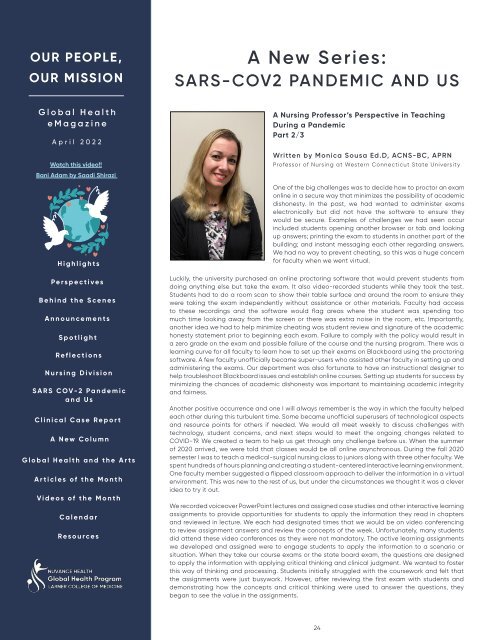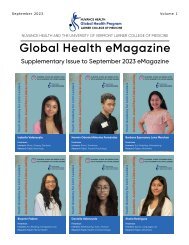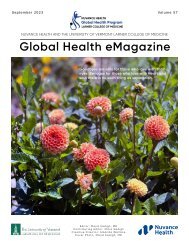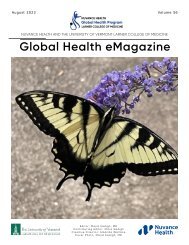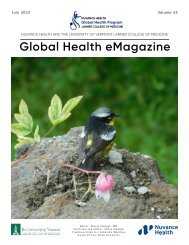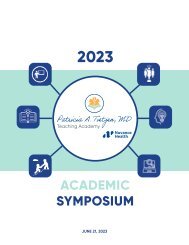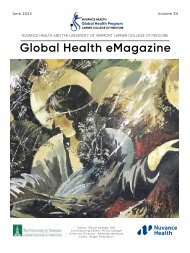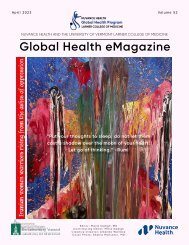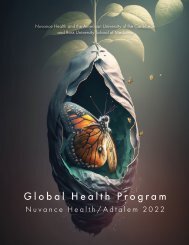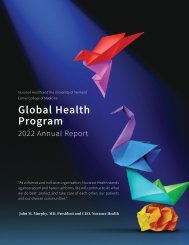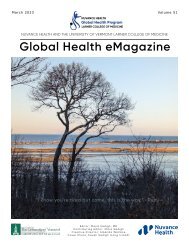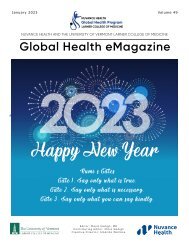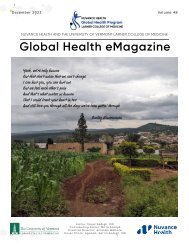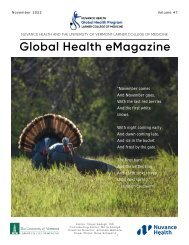April_eMagazine Volume 40
You also want an ePaper? Increase the reach of your titles
YUMPU automatically turns print PDFs into web optimized ePapers that Google loves.
OUR PEOPLE,<br />
OUR MISSION<br />
A New Series:<br />
SARS-COV2 PANDEMIC AND US<br />
Global Health<br />
<strong>eMagazine</strong><br />
<strong>April</strong> 2022<br />
Watch this video!!<br />
Bani Adam by Saadi Shirazi<br />
Highlights<br />
Perspectives<br />
Behind the Scenes<br />
Announcements<br />
Spotlight<br />
Reflections<br />
Nursing Division<br />
SARS COV-2 Pandemic<br />
and Us<br />
Clinical Case Report<br />
A New Column<br />
Global Health and the Arts<br />
Articles of the Month<br />
Videos of the Month<br />
Calendar<br />
Resources<br />
A Nursing Professor’s Perspective in Teaching<br />
During a Pandemic<br />
Part 2/3<br />
Written by Monica Sousa Ed.D, ACNS-BC, APRN<br />
Professor of Nursing at Western Connecticut State University<br />
One of the big challenges was to decide how to proctor an exam<br />
online in a secure way that minimizes the possibility of academic<br />
dishonesty. In the past, we had wanted to administer exams<br />
electronically but did not have the software to ensure they<br />
would be secure. Examples of challenges we had seen occur<br />
included students opening another browser or tab and looking<br />
up answers; printing the exam to students in another part of the<br />
building; and instant messaging each other regarding answers.<br />
We had no way to prevent cheating, so this was a huge concern<br />
for faculty when we went virtual.<br />
Luckily, the university purchased an online proctoring software that would prevent students from<br />
doing anything else but take the exam. It also video-recorded students while they took the test.<br />
Students had to do a room scan to show their table surface and around the room to ensure they<br />
were taking the exam independently without assistance or other materials. Faculty had access<br />
to these recordings and the software would flag areas where the student was spending too<br />
much time looking away from the screen or there was extra noise in the room, etc. Importantly,<br />
another idea we had to help minimize cheating was student review and signature of the academic<br />
honesty statement prior to beginning each exam. Failure to comply with the policy would result in<br />
a zero grade on the exam and possible failure of the course and the nursing program. There was a<br />
learning curve for all faculty to learn how to set up their exams on Blackboard using the proctoring<br />
software. A few faculty unofficially became super-users who assisted other faculty in setting up and<br />
administering the exams. Our department was also fortunate to have an instructional designer to<br />
help troubleshoot Blackboard issues and establish online courses. Setting up students for success by<br />
minimizing the chances of academic dishonesty was important to maintaining academic integrity<br />
and fairness.<br />
Another positive occurrence and one I will always remember is the way in which the faculty helped<br />
each other during this turbulent time. Some became unofficial superusers of technological aspects<br />
and resource points for others if needed. We would all meet weekly to discuss challenges with<br />
technology, student concerns, and next steps would to meet the ongoing changes related to<br />
COVID-19. We created a team to help us get through any challenge before us. When the summer<br />
of 2020 arrived, we were told that classes would be all online asynchronous. During the fall 2020<br />
semester I was to teach a medical-surgical nursing class to juniors along with three other faculty. We<br />
spent hundreds of hours planning and creating a student-centered interactive learning environment.<br />
One faculty member suggested a flipped classroom approach to deliver the information in a virtual<br />
environment. This was new to the rest of us, but under the circumstances we thought it was a clever<br />
idea to try it out.<br />
We recorded voiceover PowerPoint lectures and assigned case studies and other interactive learning<br />
assignments to provide opportunities for students to apply the information they read in chapters<br />
and reviewed in lecture. We each had designated times that we would be on video conferencing<br />
to review assignment answers and review the concepts of the week. Unfortunately, many students<br />
did attend these video conferences as they were not mandatory. The active learning assignments<br />
we developed and assigned were to engage students to apply the information to a scenario or<br />
situation. When they take our course exams or the state board exam, the questions are designed<br />
to apply the information with applying critical thinking and clinical judgment. We wanted to foster<br />
this way of thinking and processing. Students initially struggled with the coursework and felt that<br />
the assignments were just busywork. However, after reviewing the first exam with students and<br />
demonstrating how the concepts and critical thinking were used to answer the questions, they<br />
began to see the value in the assignments.<br />
24


